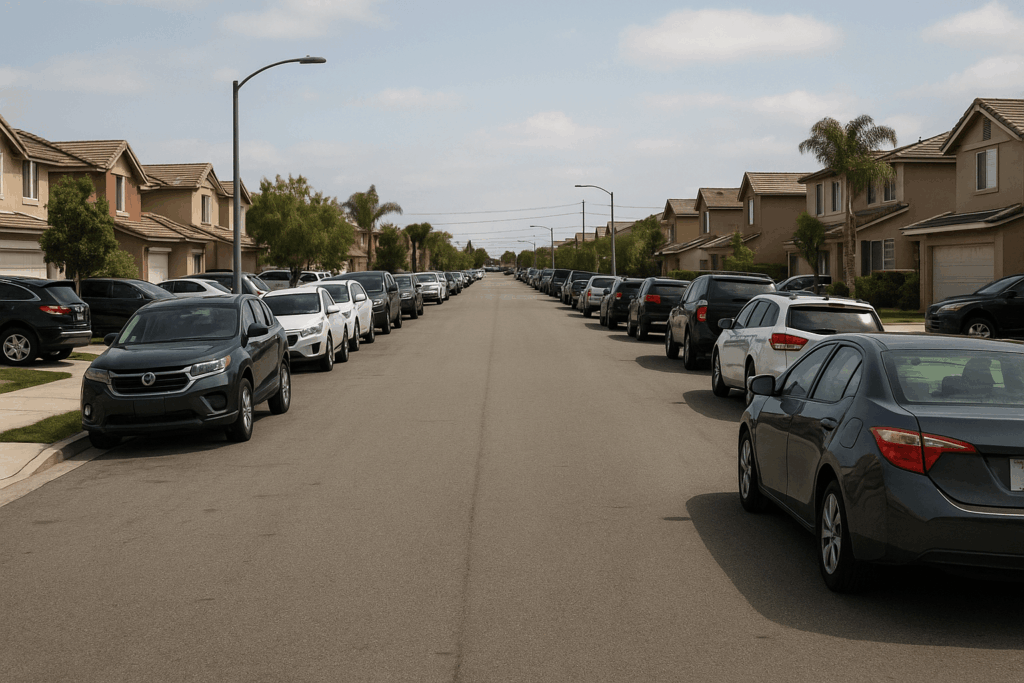Why Can’t I Park on My Own Street?
This blog features community commentary, editorial opinions, visual interpretations, and based on publicly available documents. Some images, whether labeled or stylized, are included for advocacy and awareness purposes. They may not represent final or official development plans.

If you’ve driven through much of Moreno Valley lately, you’ve seen it: cars parked bumper to bumper down residential streets, wrapped around corners, and squeezed into every inch of curb space. And if you live here, you’ve probably said it yourself:
“Why can’t I even park in front of my own house anymore?”
This isn’t just an inconvenience; it directly results from how our city was zoned and built over the last 20 years.
We Live in California, and Most Families Have More Than One Car.
Let’s be real: this is California. Public transportation is limited and far apart, and most families rely on multiple vehicles to get through the week.
Whether it’s a teen’s car, a work truck, or a second (or fourth) vehicle for commuting, those cars all need somewhere to go. But our neighborhoods weren’t built with that reality in mind.
Street Parking as a Symptom, Not the Problem
Take a drive through almost any part of “developed” Moreno Valley and you’ll see the results. Residential streets, especially in newer neighborhoods, are packed with parked cars. Some only get shuffled around to avoid street sweeping tickets, but that doesn’t solve the deeper issue.
Why is this happening?
Medium Density, Maximum Compression
Years ago, the city approved massive housing developments with medium-density zoning. That may sound like a good compromise on paper, not too dense, not too sparse, but in practice, it often meant this:
- Large houses on small lots
- Tiny driveways
- Two-car garages that rarely hold cars
If you’re like me, your garage might be full of tools, storage bins, bikes, or holiday decorations, not vehicles. And that’s not unusual. Builders know it. Planners knew it.
But the zoning code allowed these projects anyway.
Look at the newer developments near Moreno Beach and Eucalyptus, you’ll see homes packed so tightly it seems like you could jump from rooftop to rooftop. That’s medium density. Now imagine what it looks like when we jump to 9 or 10 homes per acre, as proposed in parts of East Moreno Valley. The parking situation only gets worse.
Density Without Transit Doesn’t Work
The kind of density we’ve seen, and what’s now being proposed, works in cities like New York, Chicago, or even Los Angeles, where a large percentage of residents use public transportation.
But here in Moreno Valley?
A single bus ride can take an hour or more to get across town, and you might still have to walk half a mile just to find the stop. Transit here is not built to support high-density living, and it never has been.
That disconnect with Moreno Valley street parking has been overlooked for decades, and it’s part of why our neighborhoods are overflowing with parked cars.
Sensible Planning, Not Just “How Many Can We Fit”
Yes, we need more housing. The shortage is real. But cramming units into every available corner without planning for traffic, parking, or livability is not the answer.
Zoning decisions affect your street. Your commute. Your kids’ safety. Your quality of life.
It’s time for common sense to step in.
Density should be guided by the real-world impact of what’s being built, not just how many rectangles an engineer can draw onto a map.
What You Can Do
We can’t change the past, but we can shape what happens next, especially as new rezoning proposals come forward that would bring high-density trailer parks and manufactured housing into rural, unserved areas.
👉 Join the Moreno Badlands Conservancy (It’s free!)
We’re a grassroots group of residents and neighbors advocating for sustainable, safe, and sensible growth in Moreno Valley.
Together, we can help ensure our city grows responsibly, with enough room to park.
